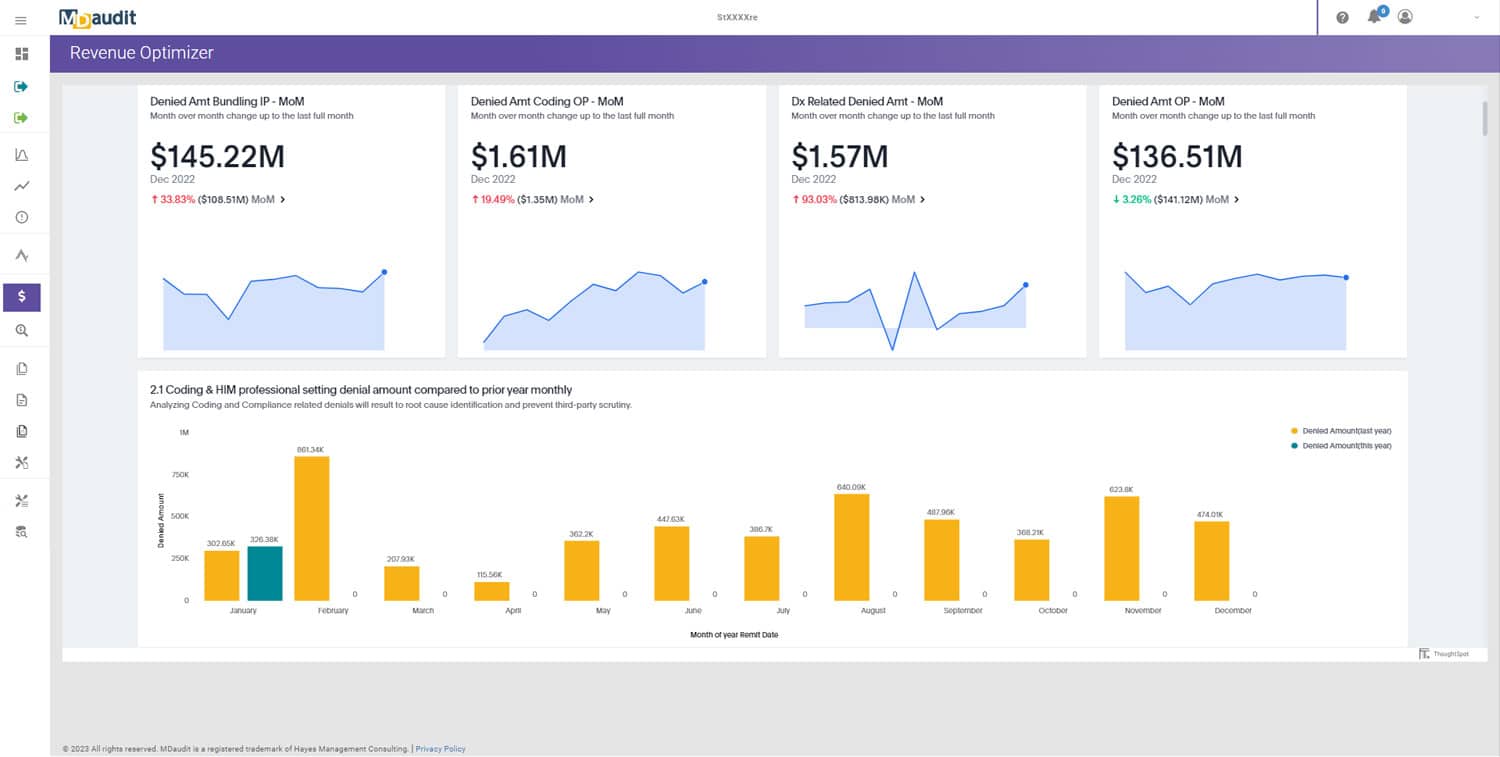Healthcare compliance is at a crossroads. As regulatory pressures grow and revenue protection becomes more critical, the traditional tools of the trade are spreadsheets, email chains, and static documentation, which are proving inadequate. Compliance teams, coding auditors, and revenue cycle leaders are increasingly realizing that these legacy methods create risk, limit visibility, and waste time.
Enter audit workflow automation, a smarter, faster, and more reliable way to manage healthcare audits and revenue integrity. Platforms like MDaudit are leading this digital transformation by unifying audit types, applying intelligent risk monitoring, and turning compliance into a strategic asset.
This blog breaks down the shift from manual to automated auditing, showcasing how healthcare organizations can streamline operations, strengthen compliance, and safeguard revenue, all from a single, integrated platform.
The Problem with Manual Audit Workflows
Spreadsheets have long been the backbone of healthcare auditing, but they were never designed to support complex, evolving compliance environments. Let’s take a look at why this legacy approach is failing modern healthcare organizations.
1. Human Error Is Inevitable
Audit workflows often rely on manual data entry and copying and pasting from (electronic health records) EHRs, exporting claims data, and keying in audit findings. Even the most meticulous teams are prone to mistakes when managing large volumes of data manually. A single formula error or data misalignment can significantly skew findings, creating misleading conclusions or exposing the organization to unnecessary risk.
2. No Real-Time Risk Visibility
Spreadsheets provide a snapshot in time. But compliance is dynamic, payer rules change, billing trends shift, and documentation standards evolve. By the time a quarterly or annual audit surfaces an issue, it may already have triggered denials, takebacks, or regulatory scrutiny.
3. Inefficiency Drains Resources
Compliance teams are often under-resourced, and manual workflows stretch them thin. Preparing audit samples, performing reviews, compiling results, and generating reports all take time. Time that could be spent on higher-value analysis or corrective action.
4. Collaboration Is Cumbersome
Auditing is a team sport. Multiple stakeholders including coders, compliance officers, department heads, and physicians need to contribute to the process. But spreadsheets don’t support real-time collaboration, version control, or task tracking. Communication gaps lead to delays and missed opportunities for remediation.
5. Audits Remain Reactive
Traditional audits often occur on a fixed schedule quarterly chart reviews, annual provider audits, etc. This approach may satisfy policy requirements, but it’s reactive by nature. It catches problems after the damage is done, rather than preventing them.
In short, manual audit workflows are slow, siloed, and insufficient for today’s compliance and revenue integrity needs.
The Case for Audit Workflow Automation
Audit workflow automation streamlines the audit lifecycle by using intelligent software to manage audit planning, execution, reporting, and follow-up. Automation reduces the administrative burden on compliance teams while increasing speed, accuracy, and accountability.
Benefits of Audit Workflow Automation:
- Automated Sampling: Random or risk-based chart selection can be performed instantly, based on configurable rules.
- Built-In Audit Forms: Standardized forms ensure consistent scoring and documentation across teams and facilities.
- Real-Time Dashboards: Track audit progress, outcomes, and trends from a centralized interface.
- Task Automation: Assign follow-up actions, reminders, or educational tasks based on findings.
- Integrated Reporting: Generate insights for leadership and regulatory bodies with a few clicks.
In platforms like MDaudit, these benefits are baked into the system empowering teams to audit more effectively, stay ahead of compliance trends, and make data-driven decisions.
Internal Audit Automation: Standardizing for Scale
Healthcare organizations conduct a variety of internal audits from routine chart reviews to documentation spot checks. Internal audit automation ensures these efforts are consistent, scalable, and aligned with organizational policy.
How It Works in Practice:
- Auditors log into a centralized dashboard and see assigned audits and deadlines.
- Sample selection is performed by the system, with automatic case distribution.
- Findings are recorded in standardized templates that align with coding, billing, and payer rules.
- Corrective actions can be triggered automatically based on error rates or types of findings.
- Reports and dashboards give leadership a real-time view of audit activity and performance.
With internal audit automation, audits become easier to manage, more defensible under scrutiny, and far less time-consuming to execute. It also allows organizations to scale their compliance efforts without scaling headcount.
Risk-Based Auditing: Focus Where It Counts
In a resource-constrained environment, not every provider, department, or procedure carries the same level of risk. That’s where risk-based auditing comes in.
Rather than auditing at random or on a fixed schedule, risk-based auditing uses real-time data to identify high-risk areas for focused review.
Examples of Risk Indicators:
- A spike in denial rates for a specific service line
- Providers with unusually high use of certain CPT codes
- Coding trends that diverge significantly from peers
- Repeat audit failures in a department or specialty
MDaudit supports risk-based auditing software capabilities by continuously analyzing claims, audit results, and payer feedback. When outliers are detected, the system can automatically flag them for review making the audit process dynamic and responsive rather than static and delayed.
This shift helps compliance teams:
- Catch problems earlier
- Prioritize limited resources
- Demonstrate a data-driven, proactive compliance posture to leadership and regulators
Unified Healthcare Audit Software: The MDaudit Advantage
One of the greatest challenges in healthcare compliance is fragmentation. Many organizations use separate tools for:
- Internal audits
- Coding quality reviews
- Denials tracking
- Risk monitoring
- Compliance reporting
This siloed approach creates inefficiencies and makes it difficult to see the full picture.
MDaudit unifies all auditing and compliance activities into one platform, offering an end-to-end solution that connects billing compliance, coding accuracy, and revenue integrity.
Core Features of MDaudit’s Unified Platform:
- Audit Workflow Automation: Supports all audit types (scheduled, risk-based, coding, denials)
- Real-Time Dashboards: Track error rates, audit status, and risk scores
- Continuous Risk Monitoring: Identify high-risk trends in near real time
- Coding Quality Reviews: Evaluate coder performance and identify training needs
- Denials Analytics: Understand root causes and prevent future revenue loss
- Integrated Reporting: Generate comprehensive reports for internal or external use
This single-source approach improves visibility, eliminates duplication of effort, and aligns compliance with revenue operations.
Continuous Risk Monitoring: Staying Ahead of Compliance Challenges
One of MDaudit’s most valuable capabilities is continuous risk monitoring the ability to track and analyze risk indicators as they emerge, not after the fact.
Rather than relying solely on scheduled audits, continuous monitoring enables compliance teams to:
- Detect outliers early
- Launch ad-hoc audits on the fly
- Assign targeted education based on emerging issues
- Compare organizational risk scores to national or regional benchmarks
For example, if a certain provider starts billing a high number of level 5 visits unexpectedly, the platform can trigger an alert or automatically assign a focused audit. This level of surveillance was impossible in the spreadsheet era but is becoming the norm thanks to tools like MDaudit.
Compliance and Revenue Integrity: Two Sides of the Same Coin
Audit automation doesn’t just improve compliance it also directly strengthens revenue integrity.
By ensuring that services are coded accurately, documentation supports billing, and errors are corrected quickly, healthcare organizations can:
- Reduce denial rates
- Prevent payer recoupments
- Shorten payment cycles
- Optimize charge capture
In today’s reimbursement landscape, where margins are tight and payer scrutiny is high, revenue integrity software is no longer a luxury. It’s essential. MDaudit helps compliance teams become revenue protectors by providing insights that tie audit findings directly to financial impact.
From Reactive to Proactive: A Cultural Shift
Perhaps the most important benefit of audit workflow automation is that it changes the entire posture of a compliance program from reactive to proactive.
Instead of waiting for problems to surface in denials or external audits, teams can:
- Monitor risk continuously
- Intervene early
- Educate providers and coders based on real-time trends
- Report on compliance progress with confidence
This shift builds a culture of continuous improvement, where compliance isn’t just about meeting requirements it’s about improving care quality, operational efficiency, and financial outcomes.
The Future of Healthcare Auditing
As technology continues to advance, so too will the expectations placed on healthcare compliance programs. Future-ready audit platforms will integrate even deeper with EHRs, apply AI to identify emerging risks, and offer predictive insights that guide compliance strategy.
MDaudit is already leading in these areas, offering:
- AI-powered risk scoring
- Predictive audit planning
- Machine learning for denial prediction
- Benchmarked compliance performance
Organizations that adopt these tools now will be better positioned to respond to change, defend against payer audits, and support a more resilient revenue cycle.
Why MDaudit?
MDaudit is purpose-built for healthcare compliance teams, offering:
- Internal audit automation
- Risk-based auditing tools
- Continuous risk monitoring
- Unified billing compliance software
- Revenue integrity analytics
- Streamlined workflows and real-time dashboards
Whether you’re a compliance officer, coding auditor, or revenue leader, MDaudit gives you the tools to reduce risk, increase efficiency, and improve financial performance all from one platform. Request a demo today.






